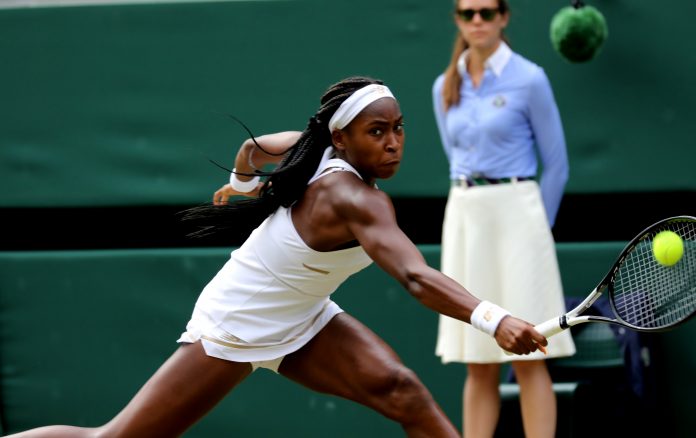Michael Mewshaw
Fifteen-year-old Coco Gauff arrived at Wimbledon like a Fourth of July rocket, sparking “oohs and “aahs” from spectators and the press. With uncanny poise and stunning skills, she won her matches and our hearts. Ranked 331 in the world, she got a wildcard into the qualies, stormed through three matches and then beat five-time Wimbledon champion Venus Williams. The tumult from that match had barely subsided when she beat former Wimbledon semifinalist Magdalena Rybarikova. That carried Coco into the third round against veteran Polona Hercog.
Inevitably her performance provoked comparisons to earlier adolescent phenoms—Tracy Austin, Andrea Jaeger, Jennifer Capriati, Martina Hingis, Steffi Graf, Monica Seles, and most recently Naomi Osaka who won the 2018 US Open at the age of 20 and followed up with the Australian Open title. Just as inevitably, Coco’s story prompted a rush of feel-good emotion. At last we have a bright, appealing young American star who inspires. She’s fresh, spontaneous and trouble-free – nothing to lose. When Steffi Graf was at this state, she said everything was perfect. Sadly, imperfection would soon come her way.
So dare we note that beneath all the giddy glee about Coco, there is also a certain, let’s not get carried away, déjà vu. Coco, we were told, was surrounded by a top-class support system. Her parents were college-level athletes, had studied tennis history and were taking steps to protect her against emotional stress and physical burn-out.
But then Coco’s father, along with prominent commentators, called for WTA rules to be rewritten so that Coco could play more than ten tourneys a year. An exceptional talent deserved exceptional treatment, they claimed, and the rule was so last century. Mr. Gauff wanted it to be tweaked so that the number of matches, not the number of tournaments, determined how often high school girls competed on the tour. A first-round loss, he observed, shouldn’t count against a player’s tournament total.
It was stunning to hear Sue Barker, Tracy Austin and Boris Becker favor changing the rule. They argued that limiting a 15-year-old’s tournament appearances could retard her development. To reach the top, you had to face top competition. After all, Tracy won the US Open at 16, and Boris won Wimbledon at 17.
What wasn’t mentioned were the consequences of early success and pressure from agents, advertisers, tournament directors and TV rights holders for teens to play when injured. Of course, Tracy Austin could cite her own experience of being sidelined by back ailments. To quote her Wikipedia entry, “Before her 21st birthday, Austin was essentially finished as a top ten player.”
Andrea Jaeger was the victim of a double whammy—a catastrophic shoulder injury and a problematic father. By 19, she was through. Even Martina Hingis, one of the game’s most precocious talents, first retired at 22 with ligament damage to both ankles. Although she came back after several surgeries, she suffered a hip injury in 2007 and almost simultaneously tested positive for cocaine.
While Hingis’s cocaine use got her suspended for two years, she would return to the tour where she wrote a fabulous chapter as a doubles champion. Still her story provides a fitting bridge to Jennifer Capriati who turned pro at 13 and seemed washed up at 17. Her struggles became fodder for tabloids Arrested for shoplifting and marijuana possession, her mug shot was heartbreaking. After drug counseling, to her great credit she returned to tennis and won the Australian and French Opens. But her post-career life has hardly been carefree. In 1994, she confided that she had considered killing herself, and in 2010 she suffered a drug overdose which some suggested was a suicide attempt.
Capriati was 15 when she reached the Wimbledon semis. Will Gauff be that lucky? Or should one say “unlucky?” Coco’s countless and well-intentioned backers might claim that what happened to other girls decades ago won’t happen to her. But the case of Osaka is fresh in the headlines and serves as a cautionary tale. At the US Open she was a brave and enchanting champion like few others. Her coach said the world could learn a lot from her innocence. Since the Australian Open, Naomi has lost to a string of lower-ranked players and withdrew from two events with injuries. Here at Wimbledon, she lost in the first round to Yulia Putintseva and asked to cut short her press conference, explaining that she was about to cry. Was this the end of innocence? It was a profoundly sad and poignant turnaround. We felt for the 21-year old who had given us so much unfiltered joy, but just ten months later seemed at such a loss.
Tennis history is full of young competitors who flamed brightly for a short time, then guttered out. That’s why the WTA instituted its age restrictions–to protect players and prolong careers. Coco deserves fabulous praise for reaching the fourth round, but why rush her? Why not let her slowly accustom herself to the tricky currents of the pro tour and pray she’s still competing when she’s Venus and Serena’s age.
Michael Mewshaw has written 22 books, most recently The Lost Prince: A Search for
Pat Conroy.



















